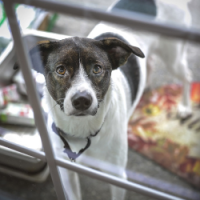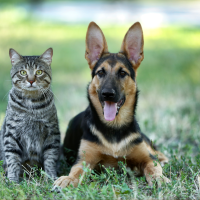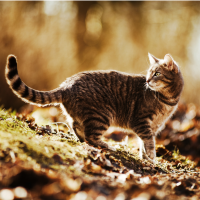Fear is an aversive emotional state with physiological, behavioral, and emotional reactions to stimuli which are perceived as an actual threat or danger. The pet’s responses are relative to the pet’s perception, even in the absence of a ‘true’ danger.
How do pets show fear?
The stimuli are simply unfamiliar but not harmful. Fears may be rational or irrational; they may be adaptive (keeps the pet safe and alive) or maladaptive (is in fact dangerous for the dog or cat itself, other pets, and people in contact with the pet).
“Behaviorally, a pet will exhibit changes in body language or activity when afraid.”
The physiological reaction results in increased heart rate, increased respiratory rate (panting), sweating, trembling, pacing, and possibly urination, defecation, and/or anal sac secretion. Behaviorally, a pet will exhibit changes in body language or activity when afraid. Subtle changes in body language may include avoiding eye contact, looking away, turning away, licking the lips, yawning, scratching, wet dog shaking, or shivering. More obvious changes in body language may include lowering of the head and body, pinning the ears back closer to the head, widening the eyes, and tucking the tail under the body. The pet may engage in active avoidance responses, such as fleeing or hiding.
“Fear may result in aggressive responses by pets.”
Fear may result in aggressive responses by pets. Aggression can be a normal behavior, and in the context of fear, it is a distance increasing signal. When presented with perceived threatening stimuli, pets may respond with defensive aggression when escape is not possible. The fight or flight response depends on the pet’s genetic predisposition, previous experience (what it has learned from similar situations in the past), and the environmental context. The first strategy for most pets is to display avoidance when afraid. If avoidance is not possible, aggression may occur. The emotional reaction in pets is most often gauged by body language rather than vocalizations. By observing body language, including piloerection (hair on the pet’s back goes up), body posture, and facial expressions, it is possible to conclude that a pet is afraid. Vocalizations when frightened may vary from high pitched whimpers or yelps to low pitched guttural growls and barks. Therefore, body language will give a clearer indication of the pet’s motivation (fear).
When presented with perceived threatening stimuli, pets may also respond with offensive aggression. The pet may have learned, when faced with a perceived threat, that growling, barking, or lunging makes the threat go away. Learning makes your pet more confident and potentially more offensive. Although your pet may look less afraid, fear still motivates the behavior.
How can these problems of fears and phobias be treated?
Professional intervention can help to prevent the behavior from worsening. If the fears are mild, then owner intervention may help to improve the problem or at the very least prevent the fear from getting worse.
- Identify and, when possible, avoid causes of fear and anxiety responses. Fearful memories may be easily consolidated and long lasting. Avoid situations, people, and places that provoke the behavior.
- Use positive reinforcement training and classical conditioning/counterconditioning. Add small readily consumed food treats to situations that have in the past induced fear responses. The sight of people and/or dogs may be associated with offering the pet a food treat. Consumption of the treat can change a negative emotion (fear) into a positive emotion. Encourage positive emotional states rather than neutral or negative experiences.
- A carefully designed desensitization and counterconditioning program to specifically address the fear or phobia can help the pet learn to overcome the fear through gradual controlled exposure and teaching alternate behavioral responses.
- Avoid adding drama with extensive coddling or consoling of the pet when he is afraid. The change in your behavior may justify or become predictive of the fear inducing stimulus, thereby exacerbating it. Alternatively, while attention may calm the pet in the moment, attention does not teach the pet to not be afraid of specific stimuli. Instead, it conditions attention-seeking as a coping strategy when the dog is afraid, leading to codependence. This coping strategy can be problematic when the pet is exposed to fear inducing stimuli in your absence. Therefore, attention and consoling should not be the primary strategy for addressing fear, phobia, or anxiety.
- Avoid using punishment or correction as a way of mitigating fear or phobic reactions. Discipline is unlikely to reduce fear, and it is likely to make the situation worse. Avoid punishment or correction in dog training. The use of punishment or correction collars (choke, pinch, or shock) is likely to exacerbate fear responses, and it may lead to aggression.
- When the situation cannot be avoided or controlled, for example a fear of thunderstorms, medications to minimize fear and anxiety are usually necessary in order to make progress and prevent sensitization.
When it comes to medications, your veterinarian can tell you the best route to take. For pets who need to be calmed from anxiety and stress, calming chews, such as Solliquin, can be helpful. Solliquin has all natural ingredients and is taken daily. If your pet is more aggressive when scared and/or the events the pet is fearful of happen only occasionally (such as storms or fireworks) causing major stress to the pet, a prescription medication may be prescribed.
At Snodgrass Veterinary Medical Center, we have multiple products that can help with numerous causes of anxiety in pets. Give us a call at 270-781-5041 to learn more or set up an appointment.
What is noise aversion?
Two out of three dogs show signs of stress and anxiety when it comes to fear induced by sounds. Of those who are fearful, 81% react to fireworks, which makes many holiday celebrations, like the Fourth of July and New Year’s Eve, a stressful time for these pets. Keeping your pet in a safe area of your home that is as far away from the noise as possible can be helpful. In many of these situations, prescription medications can also help. Your veterinarian can let you know if that is the best possible solution. Although we know what thunder and fireworks are, our pets do not, and their natural response is fear and anxiety.
Is fear ever an abnormal response in pets?
Fear can be normal and adaptive, keeping the pet safe and alive. However, there are times when fear compromises the pet’s physical and emotional health or welfare.
Fears can be maladaptive, and their presentation can be dangerous for the dog or cat itself or the people interacting with the pet. When pets are frightened, they may display aggression (fight), display avoidance by running away (flight), appear visually anxious (fret), remain rigidly still (freeze), or make small repetitive movements (fidget). The response depends on the pet’s personality (whether bold or shy), the type of stimulus presented, the previous life experiences with the stimulus, whether the pet is on its own property (where it may be more likely to defend), whether it is in the presence of offspring or family members (where it may be motivated to protect), or whether it is cornered or restrained and unable to escape (where it might display defensive aggression).
What is a phobia?
A phobia is a sudden, profound, or excessive fear response. The response is out of proportion to the stimulus and is maladaptive. Phobic responses may manifest in response to sights, sounds, or being placed in a novel environment. Phobic responses have physiological, behavioral, and emotional responses similar to fear, but they are out of proportion to the level of threat presented.
What is anxiety?
Anxiety may be defined as diffuse generalized feelings of apprehension, unease, and/or nervousness regarding an imminent event, uncertain outcome, or an anticipated threat or danger. Pets appear to anticipate or predict unpleasant situations, events, or outcomes based on previous learned experiences. Anxiety may be situational, manifesting only in specific contexts (anticipating being left home alone or a trip to the veterinary hospital) or generalized and irrespective of the environment or context (appearing anxious or nervous even when in familiar environments and regardless of the presence of companions).
“Anxiety is manifested with similar physiological signs of fear, but they occur with the anticipation of a fear inducing event.”
Anxiety is manifested with similar physiological signs of fear, but they occur with the anticipation of a fear inducing event. Anxiety may manifest in pets through excessive vocalization, destructive or escape behavior, inappropriate elimination (urination, defection, or urine marking), or compulsive, stereotypic, or repetitive behaviors like excessive grooming, panting, pacing, or drooling.
What types of stimuli might trigger a fear, phobic, or anxious response?
Triggers are varied based on the individual pet. Pets may display fear, phobic, or anxious responses associated with people, pets, sounds, objects, or environments. Fears are common in pets when going to the veterinary clinic and anxiety may manifest in anticipation of medical and/or grooming procedures. Fear or phobic responses are common with the sound of fireworks or stimuli associated with thunderstorms. Many dogs are anxious when left home alone in the absence of their preferred human companion or when confined away from human company.
What causes fearful, phobic, or anxious responses?
Sometimes fear is the result of an early experience that was unpleasant or perceived by the pet as unpleasant. If the fearful response was successful at chasing away the stimulus, or if the pet escaped from the stimulus, the behavior has been rewarded and therefore is likely to be repeated. Punishment, in close association with exposure to a stimulus, might further cause fear and anxiety toward that stimulus. If the owner is frustrated or anxious or the stimulus is threatening, this too will further aggravate (and justify) the fear. Finally, if the stimulus retreats or is removed during a display of fear aggression, the aggressive display will have been reinforced.
It does not always take an unpleasant experience for fear to develop. Any stimuli (e.g., people, places, sights, sounds) that a dog or cat has not been exposed to during its sensitive period of development, which is up to 3 months of age in dogs and 2 months of age in cats, may become a fear-evoking stimulus. For example, the dog or cat that is exposed to adults but not to children during development may become fearful when first exposed to the sights, sounds, or odors of young children. The pet’s genetics also contribute to its level of fears and phobias to stimuli.
“The triggers for these behaviors are as varied as there are breeds of dogs and cats.”
Phobic responses can occur from just one exposure or gradually increase over continued exposure. In many cases of anxiety, neurotransmitter (brain chemical) function and levels may be altered and contribute to the overall behavior. Again, learning or the consequences that follow the phobic response (escape, punishment) may aggravate the problem.
Illness, pain, or the effects of aging may lead to an increase in fear or anxiety in situations where there was previously little or no problem. These changes may alter the way a pet perceives or responds to a stimulus. Age-related changes in the brain (cognitive decline) or in the sensory system (hearing, sight), arthritis, diseases that affect the hormonal system such as an increase or decrease in thyroid hormones or an overactive pituitary gland (Cushing’s disease), and organ degeneration (liver, kidneys) are just a few examples of health- and age-related problems that might contribute to increasing fear and anxiety. A full physical examination and diagnostic tests, if indicated, are warranted for any pet with fear or anxiety, but especially those that are intense and generalized that have any other concurrent signs or that did not arise until adulthood or older age.
Is it possible to prevent fears, phobias, and anxieties?
A good program of socialization and exposure to many new and novel situations while a pet is young and in a thoughtful and proactive manner can be helpful in preventing fears and phobias. However, there is a phenomenon called single event learning, where an event is so traumatic to the individual that only one exposure can create lasting fear, phobia, or anxiety.
“However, there is a phenomenon called single event learning, where an event is so traumatic to the individual that only one exposure can create lasting fear, phobia, or anxiety.”
Owner responses when their pet experiences a new situation that could potentially be frightening are important. Calm reassurances, happy cheerful tones, and relaxed body postures of owners help pets experience new things without fear. Bringing along treats and play toys and giving them to the pet when it enters new environments (e.g., veterinary clinic, schoolyard) or when it meets new people or other pets can help create a positive association.
However, if the pet is not calmed by these things, then considering medications or removing the pet from the situation might be best. Conversely, if you show anxiety, apprehension, or frustration with your pet, or if you try to use punishment to stop undesirable behavior, you will likely make your pet more anxious. Knowing your pet and its individual temperament will help determine what situations you can and should expose your pet to. Exposure and socialization are only beneficial if it is a positive experience for the pet.
© Copyright 2019 LifeLearn Inc. Used and/or modified with permission under license.






